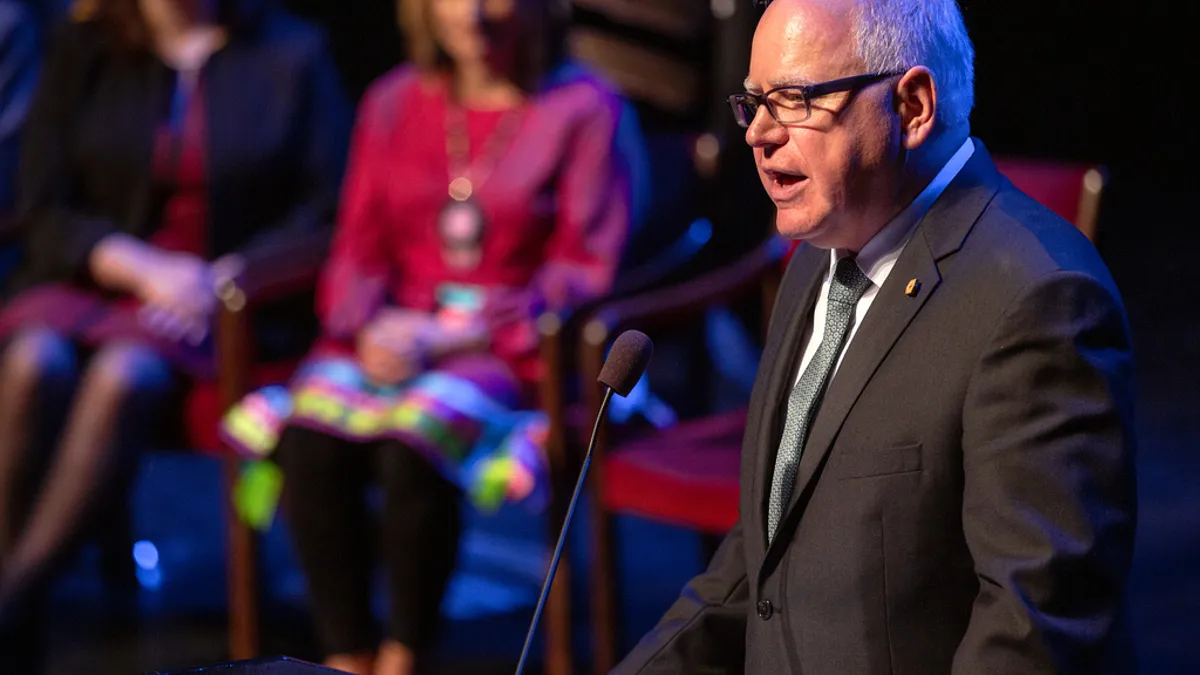Dive Brief:
-
Minnesota Gov. Tim Walz, D, on Monday proposed legislation to bring the state to 100% carbon-free electricity by 2050, revising versions of previous bills, HF 700 and SF 850, introduced to the state legislature in February.
-
The bill expands on energy efficiency programming and removes benchmark emissions requirements that utilities "have always blown by," Michael Noble, executive director of Fresh Energy in Minnesota told Utility Dive. The set of proposals, entitled "One Minnesota Path to Clean Energy" garnered positive words from two of the states largest investor-owned utilities — Xcel Energy, which committed last December to bringing its entire operation to 100% carbon-free generation by 2050, and Minnesota Power.
-
The governor's proposal follows action from a number of states: on Friday, the Washington State Senate passed a bill that would require utilities to stop producing coal-fired power by 2025 and bring the state to 100% carbon-free electricity by 2050. And a bill to bring New Mexico to 100% carbon-free energy by 2045 is heading to the State Senate floor after a "do pass" vote allowed it to advance from the Senate Corporations and Transportation Committee 5-2 on Monday.
Dive Insight:
As political leaders examine how to most efficiently curb power plant emissions across the country, state and federal leaders are grappling with nuclear's role in the clean energy transition.
Illinois, Florida and Maine have brought legislation forward to require 100% renewable energy by 2050, even though nuclear power notably dominates Illinois' electric generation. But Washington, New Mexico, Wisconsin and Minnesota are all pushing for carbon-free emissions, which can include nuclear power.
In Minnesota, Gov. Walz's proposal is a revision of a previous bill, proposed earlier this year, which called for 100% renewable energy by 2050 and drew criticism from state legislators representing the northern part of the state, which has a large mining population.
The revised version of the bill "does not rule out nuclear" and allows for landfill burning as an eligible energy source as well, according to Minnesota State Senator Nick Frentz, D, who was the chief author of the original Senate Bill, and expects to be chief author of this one as well.
It also allows for "much more collaboration and flexibility with utilities to find the path" to curbing emissions, Frentz told Utility Dive. "It's better to move in the 'all in it together' approach."
Xcel Energy "look[s] forward to working with [Walz's] administration, the legislature and other stakeholders to develop the best path forward" for the state, the company said in an emailed statement.
Minnesota Power, which serves Northeastern Minnesota and received approval in October for a controversial 550 MW natural gas plant, said it "especially appreciate[s] that the proposal is not a 'one size fits all' approach, taking into account utilities across the state are different in size, energy supply portfolio and the customers they serve," in an emailed statement.
Although the bill's efforts received positive responses from both utilities, Frentz noted that it did not have the support of Senator David Osmek, R, who chairs the Energy and Utilities Finance and Policy Committee. The state has a Republican majority Senate and Walz has "to walk a tighter rope to get things through the State Senate," J.R. Tolbert, managing director at Advanced Energy Economy, told Utility Dive in January.
"We may not see [this bill] pass the finish line," said Frentz. But climate change "is becoming more of a conversation" on both sides of the aisle, he said, adding he "would be surprised if that didn't translate into policy."
Correction: An earlier version of this article stated that the two utilities "support" Gov. Walz bills. The utilities have not given their outright support for this version but "appreciate" the bill's changes.















